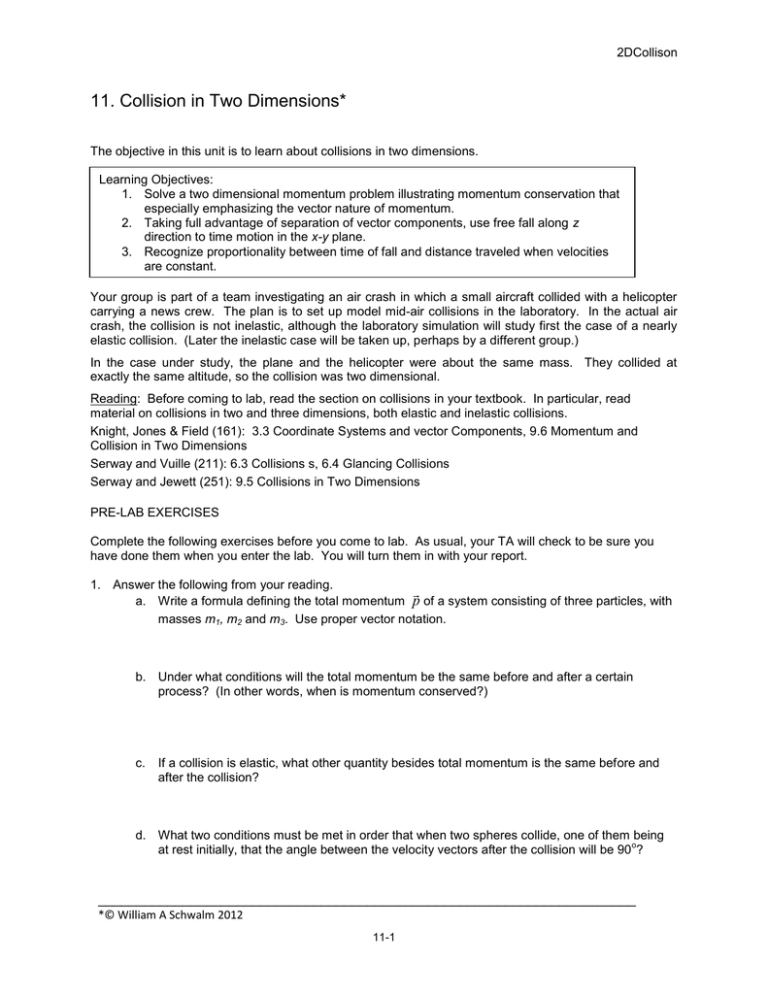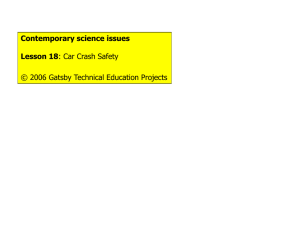11. Collision in Two Dimensions*
advertisement

2DCollison 11. Collision in Two Dimensions* The objective in this unit is to learn about collisions in two dimensions. Learning Objectives: 1. Solve a two dimensional momentum problem illustrating momentum conservation that especially emphasizing the vector nature of momentum. 2. Taking full advantage of separation of vector components, use free fall along z direction to time motion in the x-y plane. 3. Recognize proportionality between time of fall and distance traveled when velocities are constant. Your group is part of a team investigating an air crash in which a small aircraft collided with a helicopter carrying a news crew. The plan is to set up model mid-air collisions in the laboratory. In the actual air crash, the collision is not inelastic, although the laboratory simulation will study first the case of a nearly elastic collision. (Later the inelastic case will be taken up, perhaps by a different group.) In the case under study, the plane and the helicopter were about the same mass. They collided at exactly the same altitude, so the collision was two dimensional. Reading: Before coming to lab, read the section on collisions in your textbook. In particular, read material on collisions in two and three dimensions, both elastic and inelastic collisions. Knight, Jones & Field (161): 3.3 Coordinate Systems and vector Components, 9.6 Momentum and Collision in Two Dimensions Serway and Vuille (211): 6.3 Collisions s, 6.4 Glancing Collisions Serway and Jewett (251): 9.5 Collisions in Two Dimensions PRE-LAB EXERCISES Complete the following exercises before you come to lab. As usual, your TA will check to be sure you have done them when you enter the lab. You will turn them in with your report. 1. Answer the following from your reading. a. Write a formula defining the total momentum p of a system consisting of three particles, with masses m1, m2 and m3. Use proper vector notation. b. Under what conditions will the total momentum be the same before and after a certain process? (In other words, when is momentum conserved?) c. If a collision is elastic, what other quantity besides total momentum is the same before and after the collision? d. What two conditions must be met in order that when two spheres collide, one of them being o at rest initially, that the angle between the velocity vectors after the collision will be 90 ? ______________________________________________________________________ *© William A Schwalm 2012 11-1 2DCollison 2. (Phys 211 and 251, not Phys 161) In an air hockey game with two pucks of unequal mass, one puck has mass m and the other has mass 2m. The heavier puck is initially at rest and the lighter one is moving along some direction with speed vo, and hits the other one at a glancing angle. After the o collision, the lighter puck moves away from the point of impact at an angle of 90 with respect to its initial direction. If the collision is elastic, find out how fast the lighter puck is moving and also the two components of the velocity of the heavier puck after the collision. 3. Now consider the air crash. Suppose that at the instant of the crash, neither aircraft is given an initial vertical velocity. The motion of each just after the crash is in the horizontal plane. If the collision takes place at an altitude h, at what time t (how long after the crash) will the two objects both strike the ground? Show your work and explain, as always. 4. If the horizontal velocity vectors on the aircraft and the helicopter, just milliseconds after the crash, are va and vh respectively, explain how you could calculate exactly where each one should strike the ground, measured from the point on the ground directly under the crash. Be specific. 11-2 2DCollison 5. On the other hand, suppose you did not know the initial horizontal velocities. Explain how you could find the velocity vectors, knowing where the collision took place, including the altitude, and knowing where each aircraft crashed. Explain in sufficient detail. 6. Suppose the plane crashed at 470 meters west and 150 meters north of the collision, and the helicopter crashed at 220 meters south and 70 meters west of the collision. Figure out the x and y components of the two initial horizontal velocities after the crash, if the collision was at an altitude of 650 meters. Show your work and explain your reasoning in complete sentences. 7. Suppose for simplicity that the helicopter and the airplane have the same mass m. Can you figure out what the initial velocity vector of the plane was before the collision, assuming that the helicopter was stopped? Include in your explanation a statement of what physical quantity would necessarily be conserved, and why. 11-3 2DCollison Equipment: You will be using two steel balls to model the crash. One is given an initial velocity by having it roll down an incline (on a plastic ruler) while the other ball is initially at rest, sitting on top of a leveling screw. You have the plastic ruler ramp, which cab be fixed to the table, a leveling screw for positioning the target ball, a string and plumb bob for finding the point on the floor under where the collision takes place, and some butcher’s paper and carbon copy paper for recording data (crash sites). Meter sticks will also be available. Problem 1 First we need to get a handle on controlling initial speed in the modeling process. So the first thing to do is to have a way of measuring the initial speed of the moving ball before collision. One way to do it using the equipment at hand is to launch a steel ball horizontally of the edge of the table, without any collision, and to see where it falls. Doing this a few times will give some idea of how to control the initial speed before impact. 1. Prediction question: What do you know, in general, about the horizontal motion of a projectile? Explain why. 2. Prediction question: If you know the initial height above the floor, how can this be used to figure the time of flight? We need a formula here. 3. Method question: Using materials provided in the list above, how can you find a point on the floor directly under the point where the ball starts to drop? 4. Method question: By making several shots and recording where the ball hits each time, how can you estimate the precision of the measurement? Plan: After a discussion with your group members, write out an outline of how you plan to determine the initial speed of the ball before impact in the modeling experiments. You also need to know about measurement precision, so figure out how to determine that too. Implementation: Carry out your plan. Collect the data you need in order to determine the initial velocity under controlled conditions. See whether you can even vary the initial velocity in a controlled way. 11-4 2DCollison Record here with appropriate units and notes. Remember you need to be able to define the initial conditions so that another student from a different physics course could reproduce the results, given the same equipment. Analysis: From your data, see if you can find the way the initial speed is related to the conditions you tried. Show enough of your work and explain what you’re doing. Give a quantitative estimate of the error involved, and state whether or not you can actually control the initial speed effectively and repeatably. Conclusions: What did you learn? 1. Describe what you have learned about controlling the speed of the moving ball before impact. 2. Explain how you expect to make use of this in the next phase of the research. 11-5 2DCollison Problem 2 Now you need to set up a collision to simulate the air crash. 1. Prediction question: Write down a conservation law that should always hold for collisions. What quantity should be the same before and after any collision? Express this in proper mathematical notation. 2. Prediction question: (Phys 251 only) Recall two things about vector dot products: (a) dotting a vector into itself gives the square of its magnitude, and (b) when you dot two vectors together you get zero if and only if they are perpendicular. Two identical balls have the same mass. Initially, one ball is moving with initial velocity vo and the other is at rest. After the collision, the two are moving with velocity vectors v1 and v2 respectively. Take the total momentum vector before the collision and dot it into itself. Then take the total momentum vector after the collision and dot it into itself. Write these expressions down. These quantities should be equal. (Why?) 3. Prediction question: (251 only) Suppose the collision is elastic. Then what quantity should also be the same before and after the collision? Assuming that this additional quantity is indeed conserved, and using the formula from the previous question, what does this tell you about the dot product v1 v2 ? Thus, what can you conclude about the relative directions of motion of the two balls after the collision? 4. Method question: In the previous questions you showed that if the masses are equal and also the o collision is elastic, then the angle between the final velocity vectors is 90 . How will you be able to tell from measurements whether or not the laboratory collisions are elastic, or nearly elastic? 11-6 2DCollison Plan: Devise amongst yourselves a plan for making measurements to tell (a) whether or not momentum is actually conserved in laboratory conditions, and (b) whether the collisions you observe are actually elastic or not. What data do you need? What role will each group member play in taking the data? How will the data be analyzed? Record your group plan here. Implementation: Implement your plan and record the necessary data here, including correct units and comments as needed. Analysis: Now carry out the analysis needed to solve the measurement problems (a) and (b). Show example calculations and explain your analysis. 11-7 2DCollison Conclusions: What have you learned? 1. To what extent (quantitatively) do the data support your predictions? Is either or both of the two quantities we have been discussing conserved during the model collisions in the laboratory? 2. If your predictions were more or less correct, how can the model be used to study the air crash? If not, what do you thing the difficulty is in the method? 11-8






